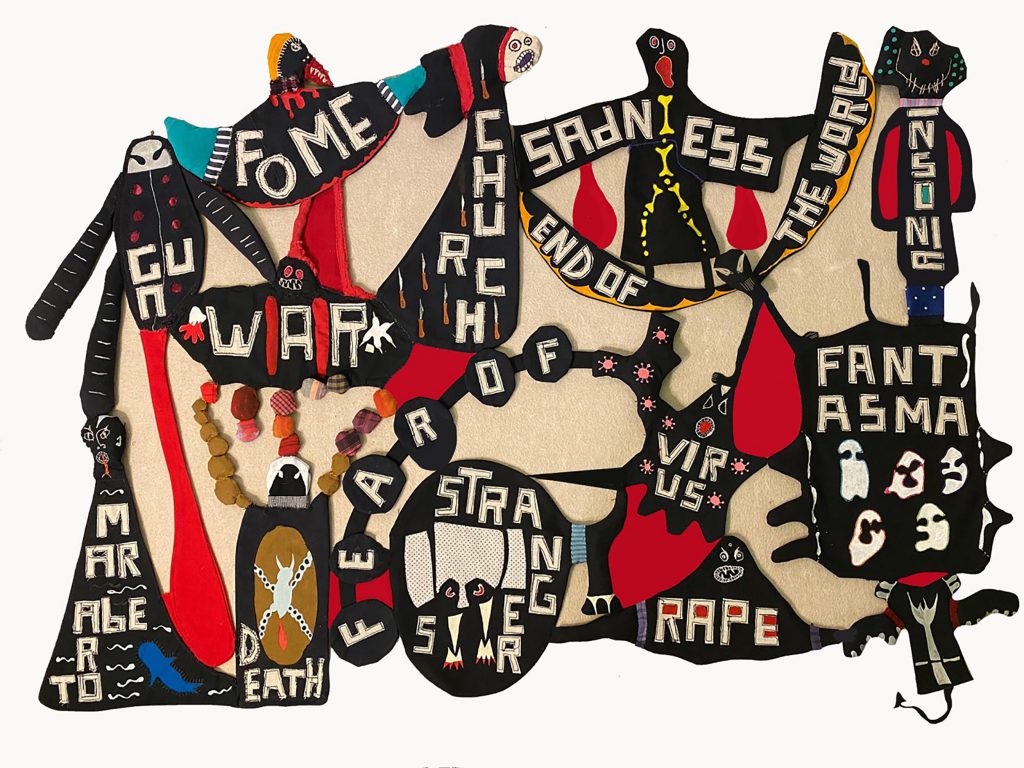
24 3/8 x 35 inches (62 x 89 cm). Photo courtesy Tanya Bonakdar Gallery.
As New York City galleries and museums begin to reopen this fall, masks and social distancing are mandatory. Some proprietors have implemented added precautions, asking to take visitors’ temperatures as they enter the gallery, or requesting names and phone numbers for possible contact tracing in the midst of the Covid-19 pandemic. Some of the larger Chelsea galleries, such as David Zwirner, Pace, and Metro Pictures, are requesting timed entrance notifications, to avoid crowds, which you can schedule online free of charge.
The various safety precautions are meant to put visitors at ease in order to better experience firsthand what is proving to be an extraordinary art season. Here below are comments on some of the outstanding and unforgettable contemporary art exhibitions currently on view. It was difficult to select just ten exhibitions to highlight, but I tried to choose shows featuring a variety of mediums and thematic concerns, plus a range of artists, from celebrated veterans and mid-career artists, to talented newcomers deserving of greater attention.
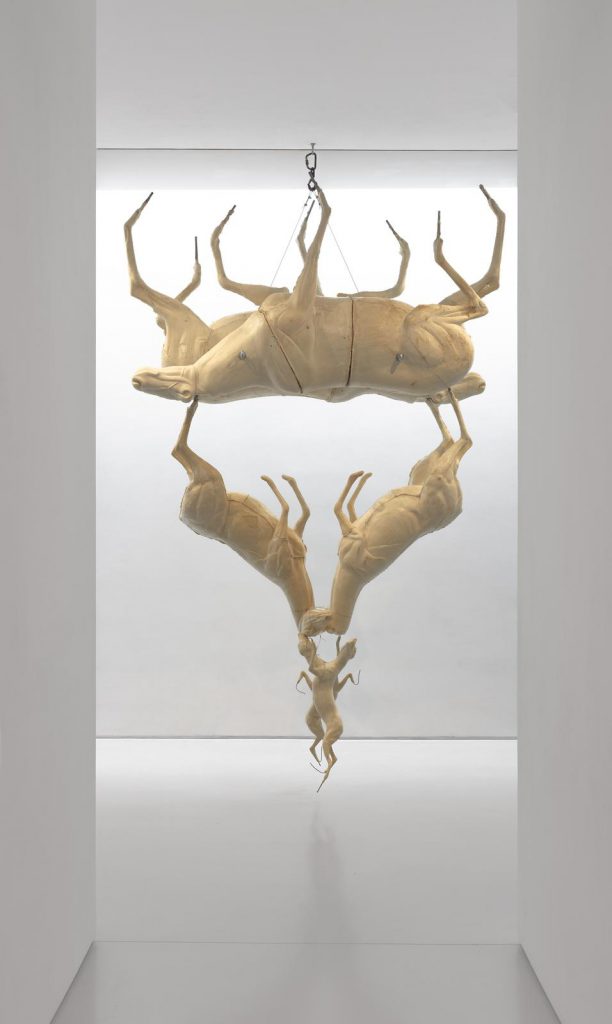
141 x 92 x 46 inches (359.4 x 233.6 x 116.8 cm), unique. Photo courtesy Sperone Westwater.
- Bruce Nauman at Sperone Westwater, through November 7.
Bruce Nauman reinforces his lofty reputation in this show of recent works that capture the disquieting disequilibrium of our present moment. On some level, the exhibition offers a continuation of Nauman’s long-term investigation of spatial relationships, and the body’s complex interaction with space and time. The fractured spaces and disjointed self-portraits that Nauman presents here also seem to metaphorically address the most acute forms of anxiety that, for many, mark the year 2020.
On view are several video projections, electronic works viewed on tablets, and one large sculpture, Two Leaping Foxes (2018). An elaborate construction made of polyurethane foam taxidermy molds for deer, caribou, and foxes, Two Leaping Foxes represents the animals as though skinned, without their protective fur, either vulnerable to the elements or anticipating the butcher. Since the late 1980s, Nauman has periodically returned to this motif, and the recent piece recalls in particular his 1989 Animal Pyramid. The animals in Two Leaping Foxes, however, are hung upside down from the gallery ceiling, adding to the palpable sense of urgency the work conveys as an emblem of the environmental distress that all wildlife faces today.
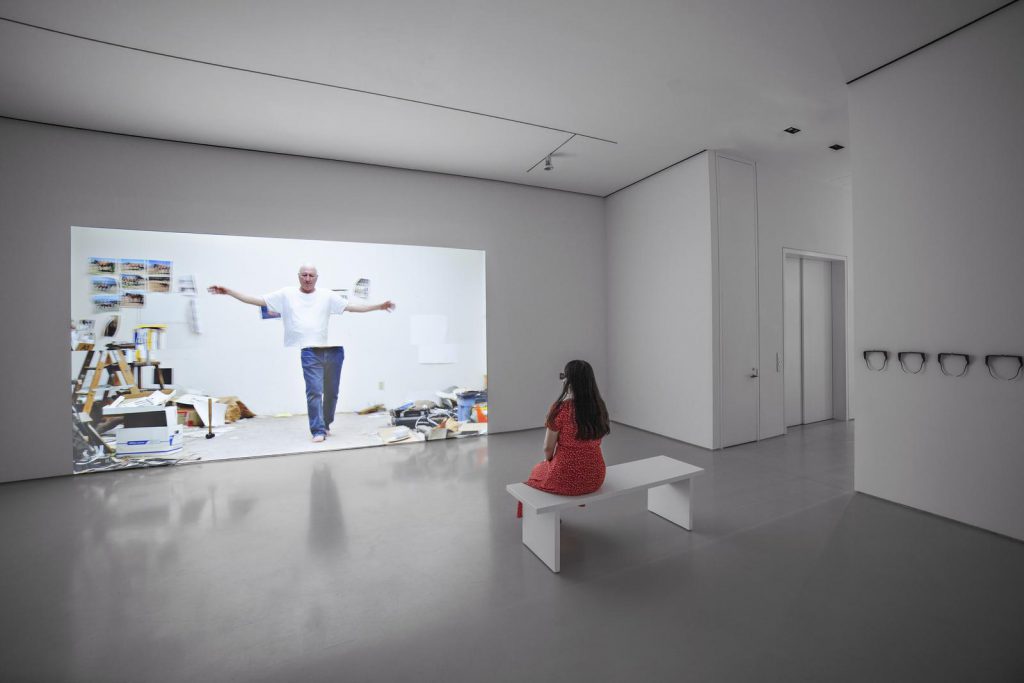
Nature Morte, the mesmerizing interactive 4K video pieces that open the show, project scenes of the artist’s studio, almost as a kind of holographic image. With views of the studio from above, all sides, and even below–as if the floor were transparent—the images are projected on the gallery wall by visitors manipulating a computer screen. Perhaps the most stunning work on view, Walking a Line (2019) follows the format of his Contrapposto Studies (2015/2016) series of video projections; here, the 3-D images (visible through 3-D glasses that the gallery provides) literally add another dimension to his fractured self-portrait in motion. In his inimitably poetic way, Nauman invites a wide range of emotional and intellectual responses to the work. It may not have been the artist’s aim, but for me at this moment, Walking a Line reflects the sociopolitical division and personal disconnectedness that afflict much of the world today. ●
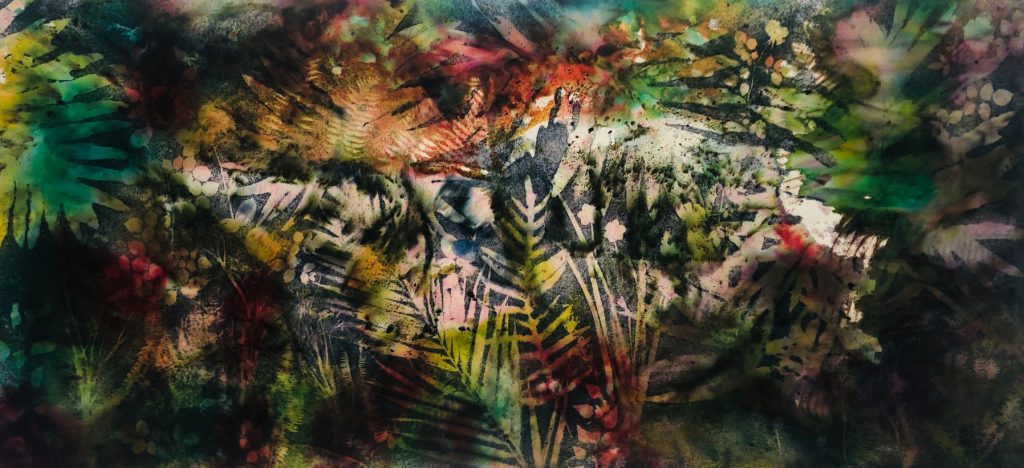
2.) Sam Falls at 303 Gallery through November 14.
The increasingly horrific TV images of the recent out-of-control wildfires in California, and the destruction they have wrought, has been heartbreaking and profoundly disturbing, especially if in the past you have spent some time in those magical environments. Political rankling over the causes, and the issues of climate change that go virtually unheeded year after year, add another layer of frustration and anxiety to the disaster. In this unabashedly gorgeous exhibition, Los-Angeles-based photo-artist Sam Falls, who has spent years studying and photographing in national forests, offers a view of—and also an attitude about—the environment in his paintings and ceramic wall reliefs that is at once elegiac and hopeful.

16 3/4 x 11 1/2 x 3 1/4 inches (42.5 x 29.2 x 8.3 cm). Photo courtesy
303 Gallery.
The large horizontal painting Paradise, for instance, a palimpsest of photo-based imagery and pigment exposed to the elements, shows a wide expanse of palm fronds and other tropical foliage densely packed into the space. A bright white light seems to emanate from the central part of the composition as if the verdant jungle scene were illuminated by ethereal moonlight. Characteristic of the paintings, this work harbors a completely romantic vision in which Falls successfully conveys the essence of the rain forest rather than merely presenting a scenic view. A number of the glazed ceramic works, covered with images of leaves, flowers, and other vegetation, are cast from bones or human limbs or a rib cage. Some of these works appear as masks or shields, possibly a form of memento mori, or amulets that might be used to protect nature from wholesale destruction. ●
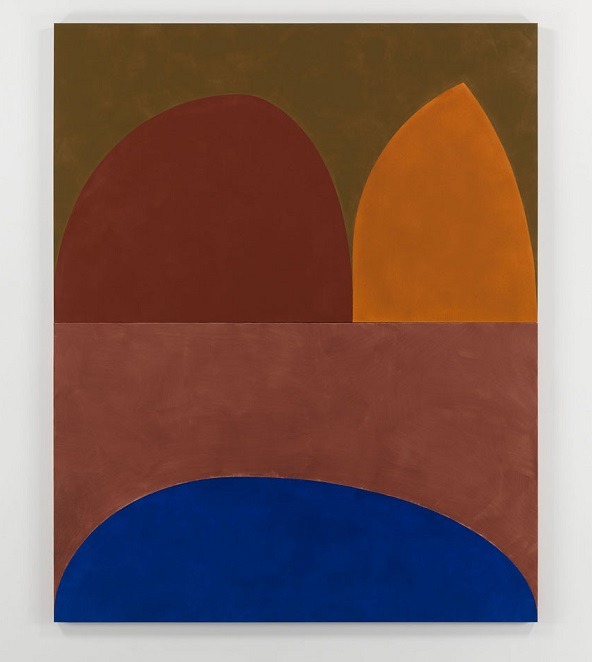
(275.6 x 222.6 cm), Panel, each: 54 1/4 x 87 5/8 inches
(137.8 x 222.6 cm). Photo courtesy David Zwirner Gallery.
3.) Suzan Frecon at David Zwirner through October 17.
Suzan Frecon’s abstract paintings test the viewer’s limits of perception. The recent large and resplendent two-panel works in this exhibition are spare compositions employing just a few rudimentary forms and a limited palette. Although her work is sometimes associated with Minimalism, the compositions do not seem to be reductive. Each canvas bears a complex luminosity and a subtle surface tension, as barely perceptible tonal shifts, and the textural play of countless layers of matte and gloss oil pigment, contribute to the unexpected visual allure. The nine-foot-tall vertical canvas stone cathedral (2019) features a conical shape in burnt orange on the upper right that does suggest the stylized dome of a cathedral.
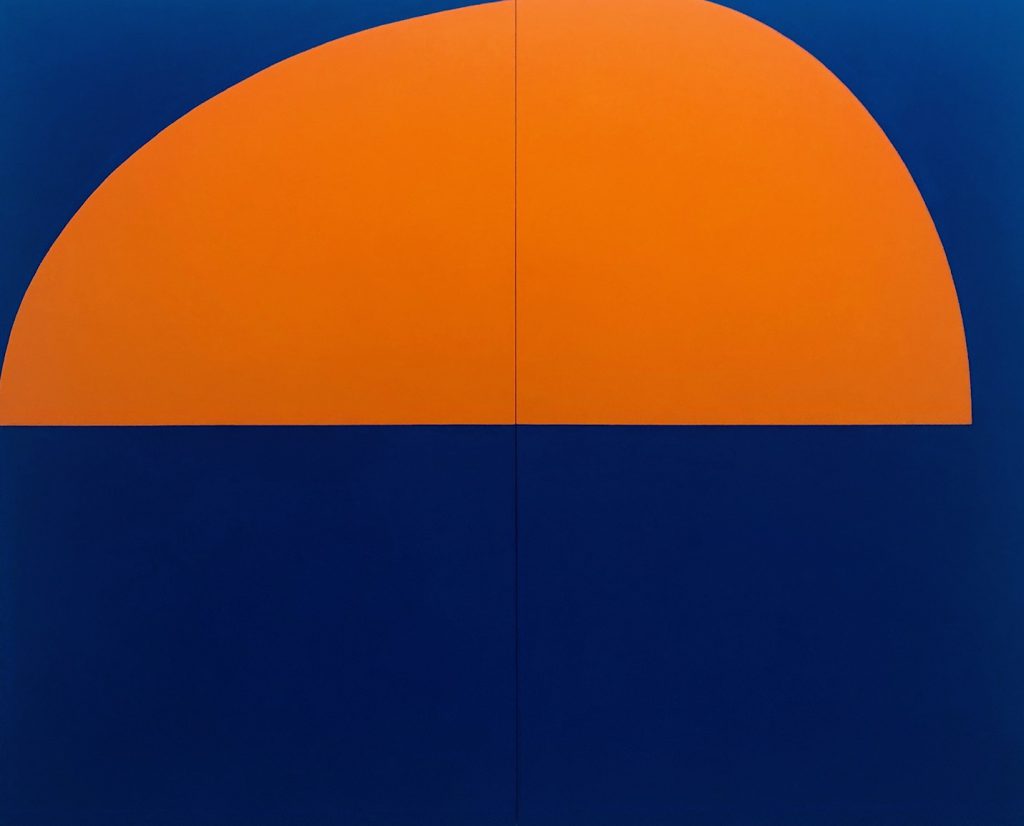
87 3/8 x 108 1/2 inches (221.9 x 275.6 cm); Each panel: 87 3/8 x 54 1/4 inches (220.9 x 137.8 cm) Photo D. Ebony.
Frecon’s works demand to be seen in person, not only due to their immersive scale, but because the color sense and the tonal relationships she establishes in each canvas are nearly impossible to capture in photographs, In his essay for the show’s catalog, poet John Yau emphasizes the importance of Renaissance paintings, such as works by Cimabue, Piero della Francesco, and Antonello da Messina, in Frecon’s color choices. One of the most striking works on view, orange and bluebird blue illumination (2019), features a glowing orange elongated half circle spanning the upper portion of the canvas. Against a deep blue background at the top, and what appears to be purplish-blue monochrome expanse at the bottom (although the color shift may be an optical illusion), the image could suggest a fiery sunset over a deep blue sea. The landscape reference seems superfluous, though, when one considers the other unique attributes of the paintings, which are central to Frecon’s refined, wholly abstract visual language.●

(Tropics: Damned, Orgasmic and Devoted 13), 2020, Cotton, wool, acrylic fiber
66 7/8 x 87 inches (170 x 221 cm). Photo courtesy Tanya Bonakdar Gallery.
4.) Rivane Neuenschwander at Tanya Bonakdar Gallery, through October 24.
This arresting show of recent works by Brazilian artist Rivane Neuenschwander features a series of large tapestries, collectively titled Trópicos malditos, gozosos (Tropics: Damned, Orgasmic and Devoted), woven in her São Paulo studio. A series of smaller acrylic-on-wood panel paintings also on view correspond directly to the images in the tapestries. Partly inspired by 17th-century Japanese erotic woodcuts, the refined, centralized images in each work contain vivid colors and crisp, sensuous lines. Instead of human figures, however, the intertwined protagonists in Neuenschwander’s works are rather uncanny hybrid creatures, part tropical insect and exotic vegetation, and in some cases bearing human limbs. Despite their formal beauty, the tapestries as well as the paintings suggest scenes of fearful violence, with a pool of blood red prominent in each composition.

(Tropics: Damned, Orgasmic and Devoted 07), 2020, Cotton, wool, acrylic fiber
66 7/8 x 93 3/8 inches (170 x 237 cm). Courtesy Tanya Bonakdar Gallery
In a rear gallery, The Order and the Method (2020), an installation of vintage postcards and texts, inspired by Jean-Luc Godard’s 1963 film Les Carabiniers, deals with fear and trauma as the aftereffects of war. The artist has indicated that she explored with the works in this exhibition the harsh sociopolitical implications of fear, and how authoritarian governments, including Brazil’s current one, use fear to manipulate and control people. One woven piece on view, Fear of (2020), directly addresses the fearful state of the world today. Texts emblazoned on the work—fear of virus, fear of sadness, fear of war, fear of the end of the world—are reminders of the anxieties that all citizens of planet Earth must overcome daily in order to survive. ●
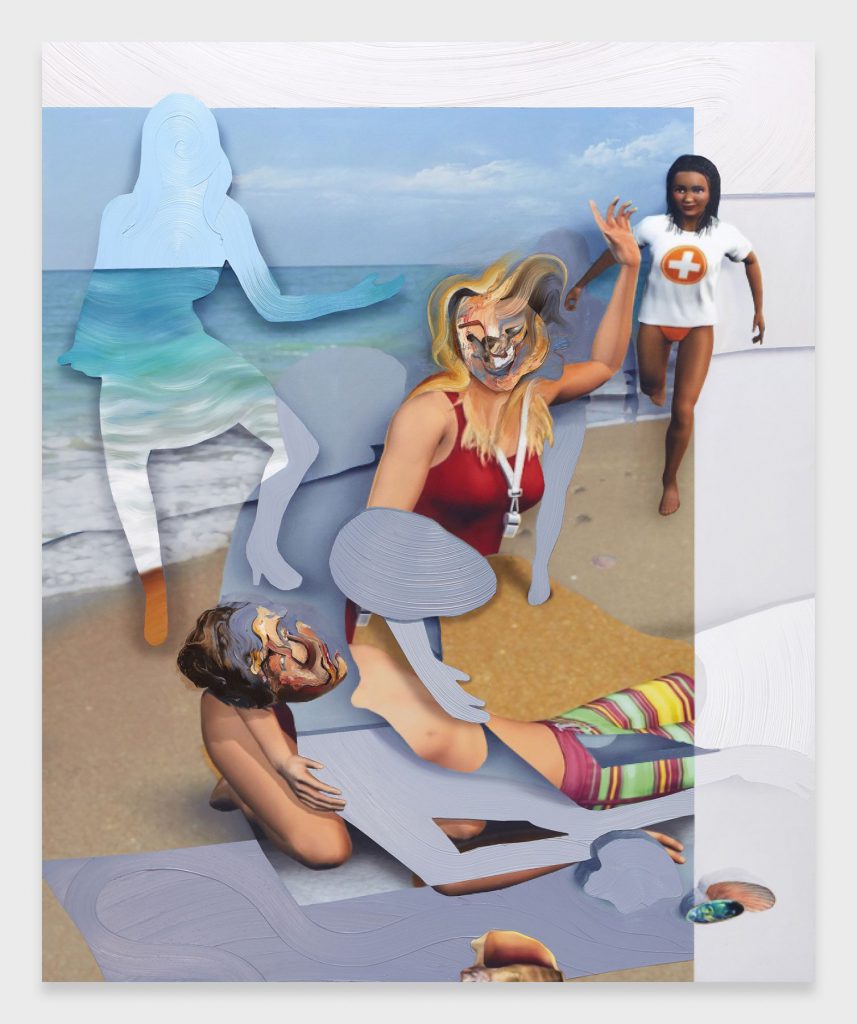
5.) Pieter Schoolwerth at Petzel Gallery through October 31.
The St. Louis-born, New York artist Pieter Schoolwerth is known for a unique hybrid of photo-enhanced painting construction, featuring riotous figure groupings, fractured spaces, and ambiguous narratives that reflect in one way or another our turbulent and largely irrational times. He based the images for this fantastic show, Shifted Sims, on screenshots from the strategic life-simulation computer game The Sims 4, in which players create and control people. In these vibrant, large-scale works, Schoolwerth offers a scathing critique of the godlike presumptuousness of video games, virtual reality, and computer CGI in general. Here, the avatars he lets loose are protagonists in various outlandish tableaux, such as a sexy Baywatch-like scene in Shifted Sims #6 (Tropical Romance Island Community Event), 2020. The people on the beach, however, with faces rendered in Francis Bacon swooshes of paint, can hardly conjure erotic content. An existentialist dilemma unfolds here, where attempts to save an apparently downing male figure leave behind a woman’s transparent silhouette hovering along the shore. This ghostly countenance, which can barely register as human, has apparently just entered another dimension.
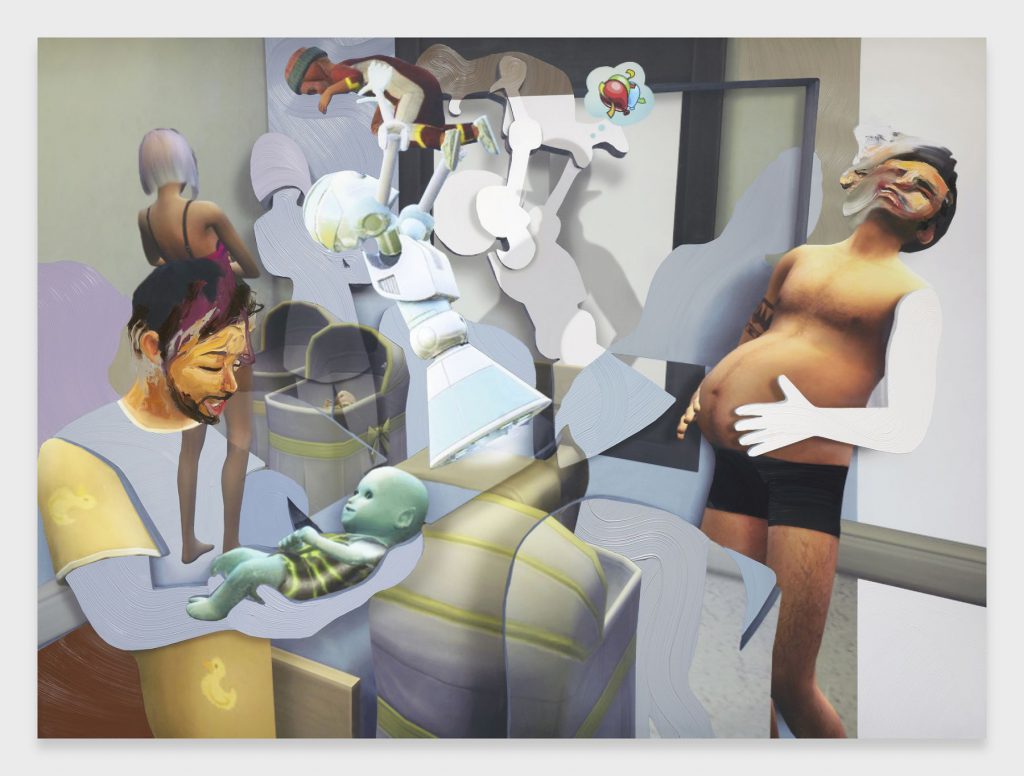
There are large doses of humor throughout the exhibition, as in Shifted Sims #10 (Male Pregnancy Mod), 2020, which shows a hospital’s elaborate medical procedure to assist pregnant males in the birthing process. Schoolwerth may be prescient, or simply a renegade upstart, but the visually arresting and conceptually stimulating works he presents in this show make an indelible impression on all who dare to come near. ●
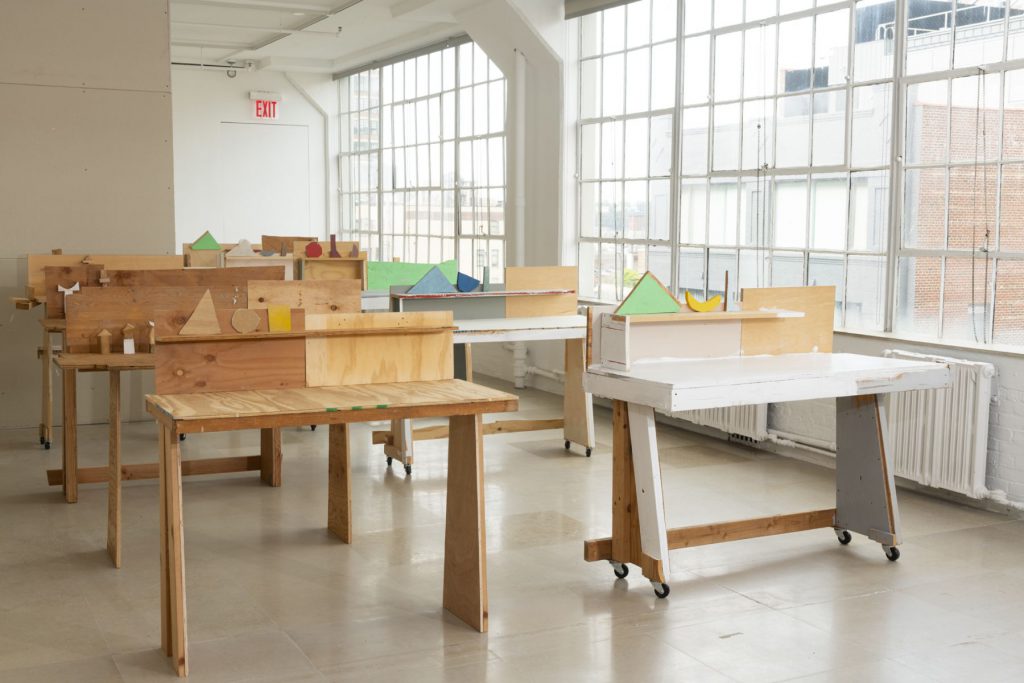
Overall dims: 56 x 143 x 338 inches (142.2 x 363.2 x 858.5 cm). Photo courtesy Greene Neftali.
6.) Gedi Sibony at Greene Neftali through October 31.
An exhibition by Gedi Sibony is a special occasion, a consistently challenging and rewarding experience. Typically (although there’s nothing typical or predictable about his process), he uses found abject objects and adds some newly handmade elements to create transcendent or otherworldly environments. For his 2018 NYC solo, The King and the Corpse, for instance, he reconstructed the remnants of a dismantled White Castle hamburger joint, transforming it into a mausoleum-like structure that he crammed into the gallery, with hardly a nod to the living. The current exhibition, The Terrace Theater, is quite a bit more welcoming and engaging, and it may be his best effort to date.

Apparently, Sibony reconstituted the remnants of the gallery’s previous exhibition, opening up walls and creating new windows–à la Gordon Matta-Clark. Continuing his rather romantic engagement with architecture, Sibony redirected the natural light sources, and created new display areas for his works that would make Marcel Duchamp proud. Visitors move through the eerily lit spaces as if in a compact museum show, highlighting Sibony’s evocative sculptures and installations. The title installation, The Terrace Theater (2019-2020), looks like a wonky Bauhaus classroom with wooden desks or worktables; it suggested to me the challenges that parents are now facing with the reality of home schooling. Among the surprises in the show are Sibony’s still-life paintings, which he has produced for some years, but which I had never seen in person before. These delicately nuanced compositions, such as Still Life with Shadows (2019), harbor a metaphysical quality that recalls Giorgio Morandi’s work. The unexpected spatial relationships in the paintings closely correspond to those in the 3-D works. ●
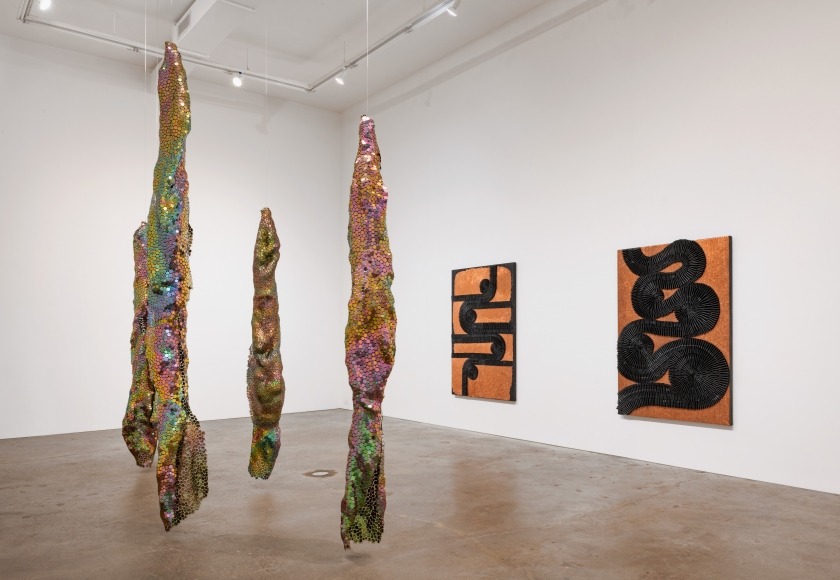
7.) Alyson Shotz at Derek Eller Gallery through October 10.
With an undergrad background in geology, New York artist Alyson Shotz has a longstanding fascination with experimental materials, ecological processes, and the effects of gravity over time. The element of time is central to The Small Clocks Run Wild, a gorgeous show of recent sculptures, wall-hung reliefs, and an installation. Suspended from the ceiling with wires, Intricate Metamorphosis is a grouping of five elongated pod-like shapes made of mesh formed by countless, interlocking metal disks. The elusive organic forms recall freshly molted snakeskins. Created using an electroplating process, the iridescent surfaces of the disks shimmer and shift in tonality as viewers move among the sculptures, changing incrementally with time.
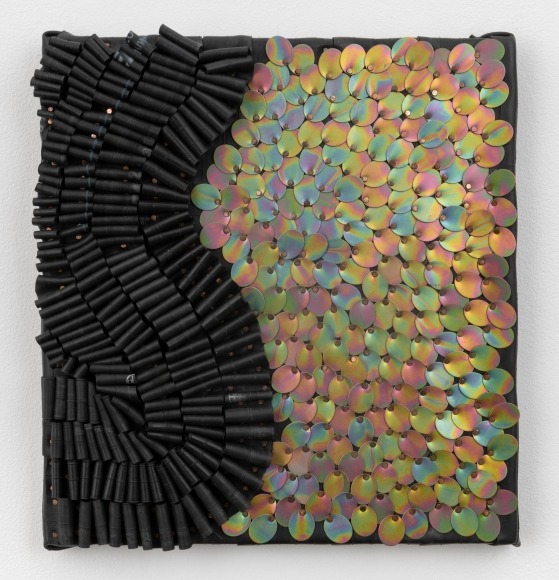
Photo courtesy Derek Eller Gallery.
Shotz borrowed the exhibition title from a line in a poem by Stanley Kunitz, contemplating his own mortality while observing salmon swimming upstream. “The great clock of your life is slowing down, and the small clocks run wild,” Kunitz wrote. The tone of the poem suits the mood of the show, which is meditative and rather melancholy. A glimmer of optimism arises, however, in the dazzling surfaces of each work, and the overall luminous atmosphere of the exhibition. In the large reliefs of the “Chronometer” series (2020), and smaller untitled works, Shotz creates a sense of graceful movement, with swirling passages of gathered and compressed strips of used bicycle tires playing counterpoint to the shimmering electroplated disks. Like memento mori dedicated to the victims of the pandemic or of social injustice, some of these meditative pieces successfully echo the emotional reverie of Byzantine icons. ●
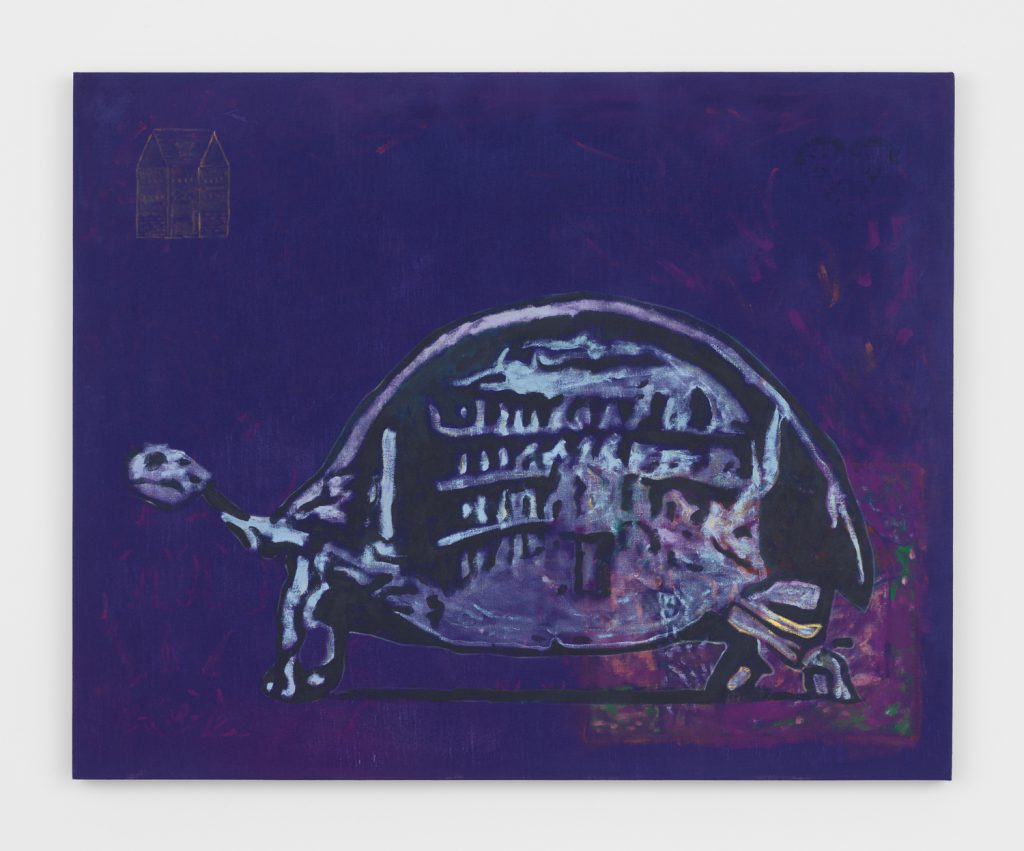
40 x 50 inches ( 101.6 x 127 cm) Photo courtesy Magenta Plains.
8.) Zach Bruder at Magenta Plains through October 21.
Gone to Fair, the title of this exhibition of recent paintings by Ohio-born New York artist Zach Bruder, 36, would appear to refer to some archaic country gathering or event, where foodstuffs and livestock would be brought to market. With spare, impressionistic brushwork, Valley (2020), for instance, shows a farmer or shepherd leading his flock of sheep through a verdant landscape, suggested by the lush, velvety green background, framed in a row of schematically rendered flowers. And the large Bounty (2020) shows two arrangements of fruits and vegetables, rendered with abbreviated brushstrokes and set against a bright orange background.
These centralized compositions in a limited but sumptuous palette, feature figures, animals and objects culled from the artist’s extensive archive of antique images. They often recall a form of faux folk art. Here and there, though, Bruder leaves unresolved passages of furtive brushstrokes that add a significant amount of surface tension, and thus situate the works clearly within the discourse of contemporary painting.
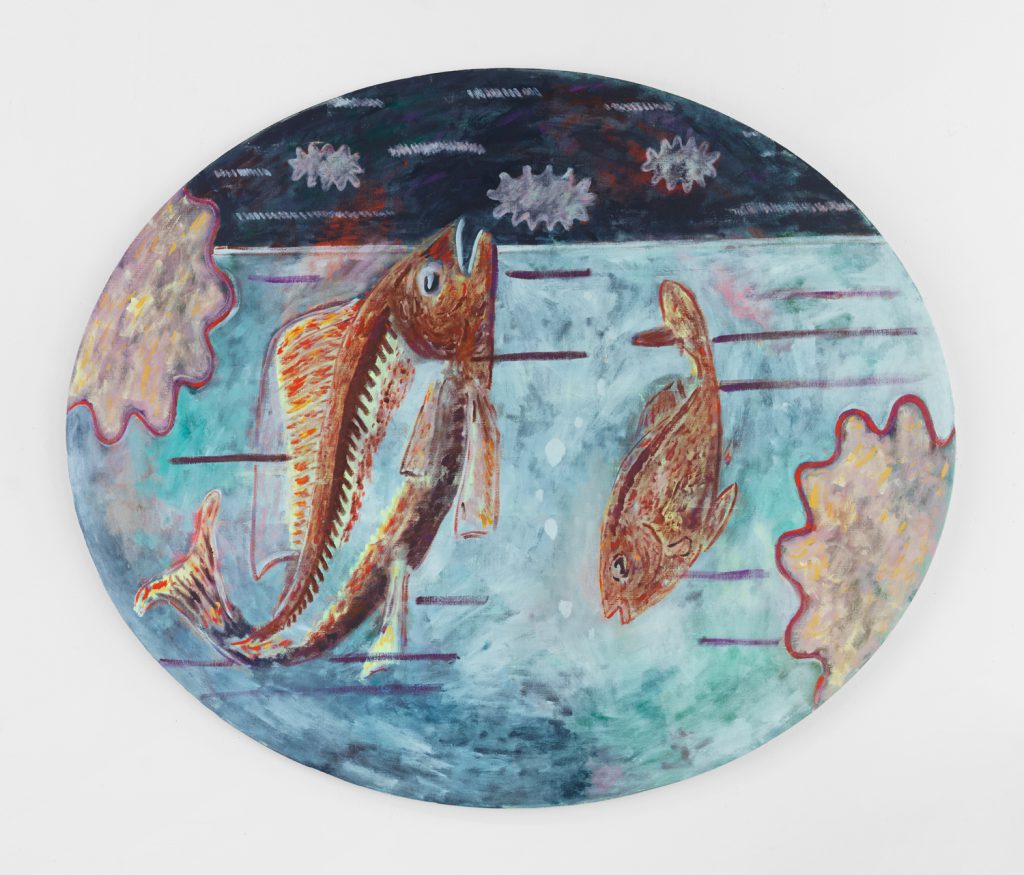
Photo Courtesy Magenta Plains.
One of the most striking pieces, Make Haste Slowly (2020), shows a turtle skeleton against a deep, blue-purple background. Its cutaway body reveals the interior of the Pantheon in Rome, summarily rendered with feathery brushwork. Another memorable piece, Divination (2020), an oval-shaped composition, features two stylized fish swimming in a fishbowl. Since the artist’s astrological sign is Pisces, there seems to be a self-referential or personal significance to the image. Its execution, however, conjures a work of ancient Roman painting or mosaic, especially of the early Christian period. This painting, as most of Bruder’s work in Gone to Fair, evokes a more innocent time and place—a rather idyllic past. Sociopolitical strife and pandemic fears seem distant and unfathomable. Their obviously deliberate absence, however, is a statement unto itself, and ultimately underscores the uncertainty and anxiety of the present.●

Photo courtesy Marianne Boesky Gallery.
9.) Gina Beavers at Marianne Boesky Gallery through October 17.
At first, Gina Beavers’s garish and provocative large-scale wall relief paintings of figures and body parts in this show, World War Me, struck me as sensational merely for the sake of sensation. Despite social media references in some works, the Athens, Greece-born, New Jersey-based artist, taps into the familiar iconography of Pop art–especially the more brash offerings of Andy Warhol, Tom Wesselmann, Larry Rivers, and Marisol, as well as Euro-Pop favorites like Martial Raysse. Giant red lips abound in the show, as well as rows of eyes with heavy makeup, and cheeky self-portraits. One Beavers work, however, stopped me in my tracks, changed my mind, implored me to take notice, take my time, and revisit the exhibition. This large composition, some six-by-six feet, and seven inches thick, Painting Lee Bontecou’s ‘Untitled 1967’ on my Cheek (2020), shows various renditions of Lee Bontecou’s well-known wall relief emblazoned on the artist’s face, in a dozen such images arranged in a grid. More than an homage to the veteran artist, the work neatly reflects the formal properties of Beavers’s work, and with a welcome touch of humor, elevates it from a potential kitsch knock-off to a significant esthetic achievement.
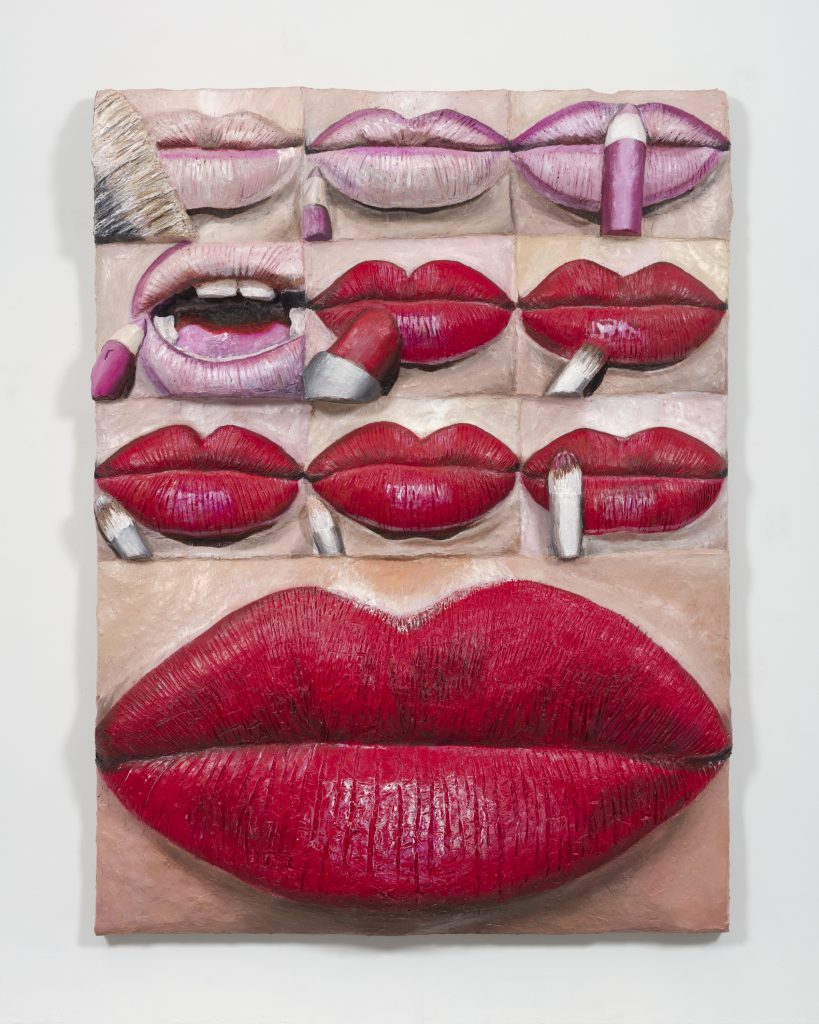
96 x 72 x 6 inches (243.8 x 182.9 x 15.2 cm) Photo courtesy Marianne Boesky Gallery.
In press statements, Beavers remarks that she was inspired by “the tools of creativity that are proliferating online, particularly when people apply these to their own bodies, from elaborate face and body painting to nail art. . . for World War Me I began to use these tools on my own body, borrowing techniques from the internet, to make certain artists and their work a part of my own physical self.” Other paintings on view, such as the imposing Passo a Passo (Step by Step), 2020—in which the artist replicates her own lips, and explores some sort of lipstick application progression–suddenly appear as rather daunting and provocative monuments to self-obsession, which is, as Beavers suggests, the combustive force that fuels social media.●

10.) Vadis Turner at Geary through October 31.
Creating engaging works of raucous material density, and subtly nuanced thematic richness, Tennessee-based Vadis Turner, 43, presents in this compact and elegant show, Cups and Grids, a group of vessel-like constructions and several large-scale abstract wall reliefs. Inspired in equal parts by Brutalist architecture–that much maligned and now endangered species of modernist buildings–and a study of moths, each of Turner’s works features a precarious balance of formal elements–deliberately clunky ingredients countering delicately fragile touches.
In Eyespots (2020), for instance, roughhewn, irregular blocks of mineral wool, covered in resin and white-gray paint and dyes, arranged in a more or less circular shape, some seven-feet in diameter and protruding nearly a foot from the wall, appear to be materials gathered from a construction site. On closer inspection, two small rectangles of sheer pink fabric, nonchalantly pinned to two of the blocks, thwart the initial sense of the work’s gritty, industrial demeanor.
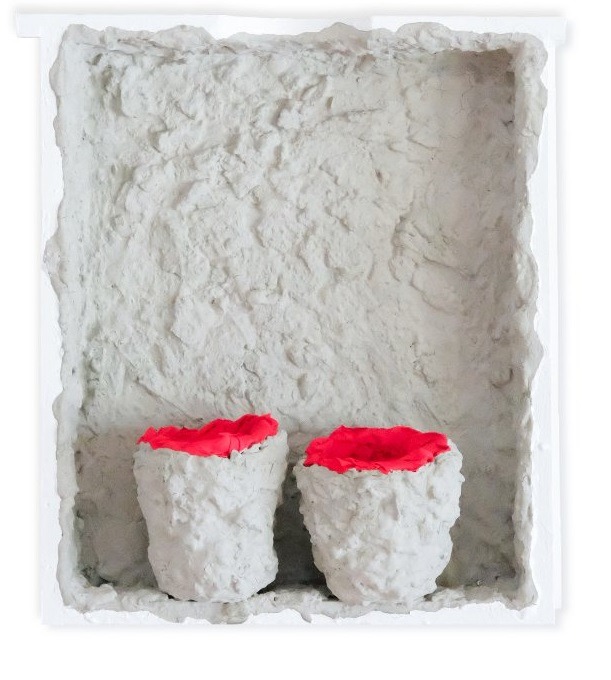
20 1/2 x 19 x 6 inches (52.1 x 48.3 x 15.2 cm). Photo courtesy Geary.
In a number of pieces, Turner uses bright red bedsheets, rolled up and woven into large constructions, as in the imposing Red Findings (2020). This work, and a number of others on view, suggest a domestic narrative. The searing red of Red Findings seems to indicate either passion or fury in the bedroom–or perhaps both. Homages to forbears like Eva Hesse, Harmony Hammond, and Richard Tuttle are evident in the work, but Turner establishes her own unique vision and material reality in Cups and Grids. What you see is what you get in the wall-hung Two Cups in a Dresser Drawer, Cement and Bedsheets (2020), an unapologetic ode to still life and its traditions. However, with its two lumpy concrete vessels filled with red bedsheet fabric, set in a cement-filled drawer, Turner proposes in this work a new sort of genre.●
Text ©David Ebony 2020. @davidebony [email protected]
Solved my doubts, thank you this subject is very interesting finally found a good post on this subject, thanks i’m always learning more.
Your website is amazing congratulations, visit mine too:
https://strelato.com
.
Brilliant information here! Hopefully you wont stop the flow of such magical material!
Your site visitors, especially me appreciate the time and effort you have spent to put this information together. Here is my website QU6 for something more enlightening posts about Cosmetic Treatment.